Summary
The poem begins with the narrator who, alone and unable to sleep, begins to read Boethius' Consolation of Philosophy . At first, he reads in the hope that it will help him get back to sleep, but he quickly becomes interested in the text and its treatment of Boethius' own experience of misfortune. At last, he begins to think about his own youthful experience, and how he came to a life of misery. On hearing the Matins bell, he rises and begins to write a poem describing his fate. He begins with a sea voyage taken when he was twelve years of age, when he was captured and imprisoned for eighteen years. Whilst in prison, he feels isolated, believing himself to be the most miserable man living. The sight of birds singing outside his prison window draws him back into the outside world. Looking out, he sees a beautiful woman, and falls in love. This woman is ultimately to be the means of his liberation, and this sequence of events closely parallels the biography of James I of Scotland. James's imprisonment came to an end with his marriage to Joan Beaufort whose name may be punningly referenced in the 'flour jonettis' which the beloved lady wears in her hair (stanza 47).
When the lady departs, the narrator becomes desperately sad, and eventually falls into a trance. In a dream, he visits three goddesses, who address his love-problem. The first, Venus, admits that she has no authority in this case, and directs him to Minerva, who probes the nature of his love. Once satisfied that his desires are pure, rather than being simple lust, she advises him on the nature of free will, telling him that he must cultivate wisdom if he is to avoid being prey to changing fortunes. Finally, he descends to the earthly paradise, where he sees Fortune and her wheel, which fill him with fear. Fortune sets him to climb on her wheel, and, as she pinches his ear, he awakes.
Consumed by doubt, the narrator is reassured by the appearance of a turtle dove carrying a message, signalling the beneficent quality of his vision. The narrator claims that Fortune kept her promise to him by increasing his wisdom, so that he is now in a state of happiness with his beloved. The poem closes with the narrator offering thanks to all who, at the end of the poem, brought about his good fortune, and a dedication to the 'poetis laureate' Geoffrey Chaucer and John Gower. The poem's penultimate verse repeats its first line, 'heigh in the hevynnis figure circulere', so that its structure echoes that of the celestial spheres that it evokes.
Rhyming Scheme
The Kingis Quair uses the Chaucerian rhyme scheme rhyme royal: ABABBCC. The form was once thought to have been named for James I's usage, but scholars have since argued that it was named for its reference to the French chant royal. [3]
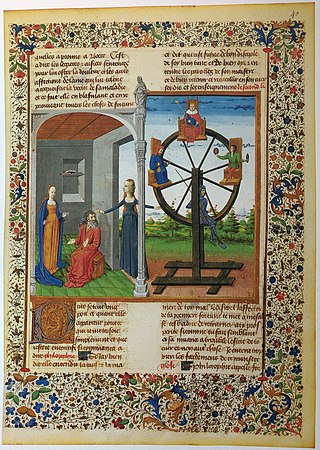
On the Consolation of Philosophy, often titled as The Consolation of Philosophy or simply the Consolation, is a philosophical work by the Roman philosopher Boethius. Written in 523 while he was imprisoned and awaiting execution by the Ostrogothic King Theodoric, it is often described as the last great Western work of the Classical Period. Boethius' Consolation heavily influenced the philosophy of late antiquity, as well as Medieval and early Renaissance Christianity.
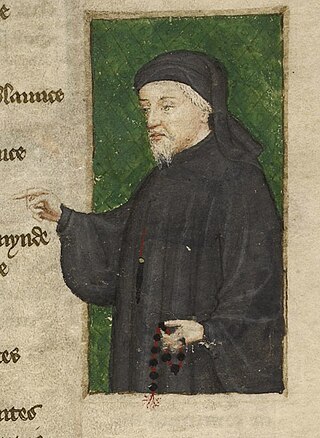
Geoffrey Chaucer was an English poet, author, and civil servant best known for The Canterbury Tales. He has been called the "father of English literature", or, alternatively, the "father of English poetry". He was the first writer to be buried in what has since come to be called Poets' Corner, in Westminster Abbey. Chaucer also gained fame as a philosopher and astronomer, composing the scientific A Treatise on the Astrolabe for his 10-year-old son Lewis. He maintained a career in the civil service as a bureaucrat, courtier, diplomat, and member of parliament.
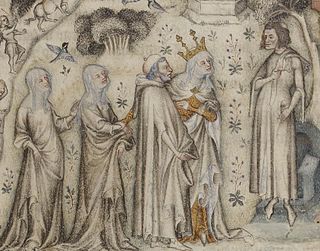
Guillaume de Machaut was a French composer and poet who was the central figure of the ars nova style in late medieval music. His dominance of the genre is such that modern musicologists use his death to separate the ars nova from the subsequent ars subtilior movement. Regarded as the most significant French composer and poet of the 14th century, he is often seen as the century's leading European composer.

The Romaunt of the Rose is a partial translation into Middle English of the French allegorical poem, Le Roman de la Rose. Originally believed to be the work of Chaucer, the Romaunt inspired controversy among 19th-century scholars when parts of the text were found to differ in style from Chaucer's other works. Also the text was found to contain three distinct fragments of translation. Together, the fragments—A, B, and C—provide a translation of approximately one-third of Le Roman.
Rhyme royal is a rhyming stanza form that was introduced to English poetry by Geoffrey Chaucer. The form enjoyed significant success in the fifteenth century and into the sixteenth century. It has had a more subdued but continuing influence on English verse in more recent centuries.
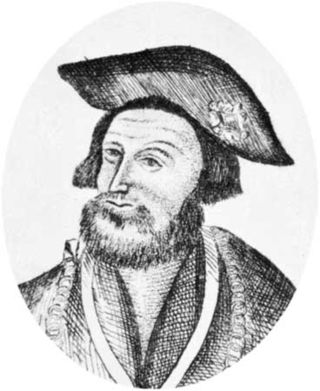
Sir David Lyndsay of the Mount was a Scottish knight, poet, and herald who gained the highest heraldic office of Lyon King of Arms. He remains a well regarded poet whose works reflect the spirit of the Renaissance, specifically as a makar.

John Lydgate of Bury was an English monk and poet, born in Lidgate, near Haverhill, Suffolk, England.

The Parlement of Foules, also called the Parlement of Briddes or the Assemble of Foules, is a poem by Geoffrey Chaucer made up of approximately 700 lines. The poem, which is in the form of a dream vision in rhyme royal stanza, contains one of the earliest references to the idea that St. Valentine's Day is a special day for lovers.

"The Knight's Tale" is the first tale from Geoffrey Chaucer's The Canterbury Tales.

Troilus and Criseyde is an epic poem by Geoffrey Chaucer which re-tells in Middle English the tragic story of the lovers Troilus and Criseyde set against a backdrop of war during the siege of Troy. It was written in rime royale and probably completed during the mid-1380s. Many Chaucer scholars regard it as the poet's finest work. As a finished long poem it is more self-contained than the better known but ultimately unfinished The Canterbury Tales. This poem is often considered the source of the phrase: "all good things must come to an end" (3.615).
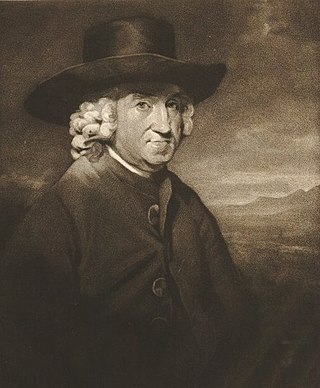
William Tytler WS FRSE (1711–1792) was a Scottish lawyer, known as a historical writer. He wrote An Inquiry into the Evidence against Mary Queen of Scots, against the views of William Robertson. He discovered the manuscript the "Kingis Quhair", a poem of James I of Scotland. In 1783 he was one of the joint founders of the Royal Society of Edinburgh.
John Hardyng was an English chronicler. He was born in Northern England.
Adam Pinkhurst is best known as a fourteenth-century English scribe whom Linne Mooney identified as the 'personal scribe' of Geoffrey Chaucer, although much recent scholarship has cast doubt on this connection.

Pierce the Ploughman's Crede is a medieval alliterative poem of 855 lines, lampooning the four orders of friars.
The term Middle English literature refers to the literature written in the form of the English language known as Middle English, from the late 12th century until the 1470s. During this time the Chancery Standard, a form of London-based English became widespread and the printing press regularized the language. Between the 1470s and the middle of the following century there was a transition to early Modern English. In literary terms, the characteristics of the literary works written did not change radically until the effects of the Renaissance and Reformed Christianity became more apparent in the reign of King Henry VIII. There are three main categories of Middle English literature, religious, courtly love, and Arthurian, though much of Geoffrey Chaucer's work stands outside these. Among the many religious works are those in the Katherine Group and the writings of Julian of Norwich and Richard Rolle.

Confessio Amantis is a 33,000-line Middle English poem by John Gower, which uses the confession made by an ageing lover to the chaplain of Venus as a frame story for a collection of shorter narrative poems. According to its prologue, it was composed at the request of Richard II. It stands with the works of Chaucer, Langland, and the Pearl poet as one of the great works of late 14th-century English literature. The Index of Middle English Verse shows that in the era before the printing press it was one of the most-often copied manuscripts along with Canterbury Tales and Piers Plowman.

In medieval and ancient philosophy the Wheel of Fortune, or Rota Fortunae, is a symbol of the capricious nature of Fate. The wheel belongs to the goddess Fortuna who spins it at random, changing the positions of those on the wheel: some suffer great misfortune, others gain windfalls. The metaphor was already a cliché in ancient times, complained about by Tacitus, but was greatly popularized for the Middle Ages by its extended treatment in the Consolation of Philosophy by Boethius from around 520. It became a common image in manuscripts of the book, and then other media, where Fortuna, often blindfolded, turns a large wheel of the sort used in watermills, to which kings and other powerful figures are attached.
Chaucer's influence on 15th-century Scottish literature began towards the beginning of the century with King James I of Scotland. This first phase of Scottish "Chaucerianism" was followed by a second phase, comprising the works of Robert Henryson, William Dunbar, and Gavin Douglas. At this point, England has recognised Scotland as an independent state following the end of the Wars of Scottish Independence in 1357. Because of Scottish history and the English’s recent involvement in that history, all of these writers are familiar with the works of Geoffrey Chaucer.

The Testament of Cresseid is a narrative poem of 616 lines in Middle Scots, written by the 15th-century Scottish makar Robert Henryson. It is his best known poem. It imagines a tragic fate for Cressida in the medieval story of Troilus and Criseyde which was left untold in Geoffrey Chaucer's version. Henryson's cogent psychological drama, in which he consciously resists and confronts the routine depiction of Cressida (Cresseid) as simply 'false', is one of the features that has given the poem enduring interest for modern readers and it is one of the most admired works of northern renaissance literature. A modern English translation by Seamus Heaney, which also included seven of Henryson's fables from The Morall Fabillis, was published in 2009.
The Floure and the Leafe is an anonymous Middle English allegorical poem in 595 lines of rhyme royal, written around 1470. During the 17th, 18th, and most of the 19th century it was mistakenly believed to be the work of Geoffrey Chaucer, and was generally considered to be one of his finest poems. The name of the author is not known but the poem presents itself as the work of a woman, and some critics are inclined to take this at face value. The poet was certainly well-read, there being a number of echoes of earlier writers in the poem, including Geoffrey Chaucer, John Lydgate, John Gower, Andreas Capellanus, Guillaume de Lorris, Guillaume de Machaut, Jean Froissart, Eustache Deschamps, Christine de Pizan, and the authors of the "Lai du Trot" and the Kingis Quair.













